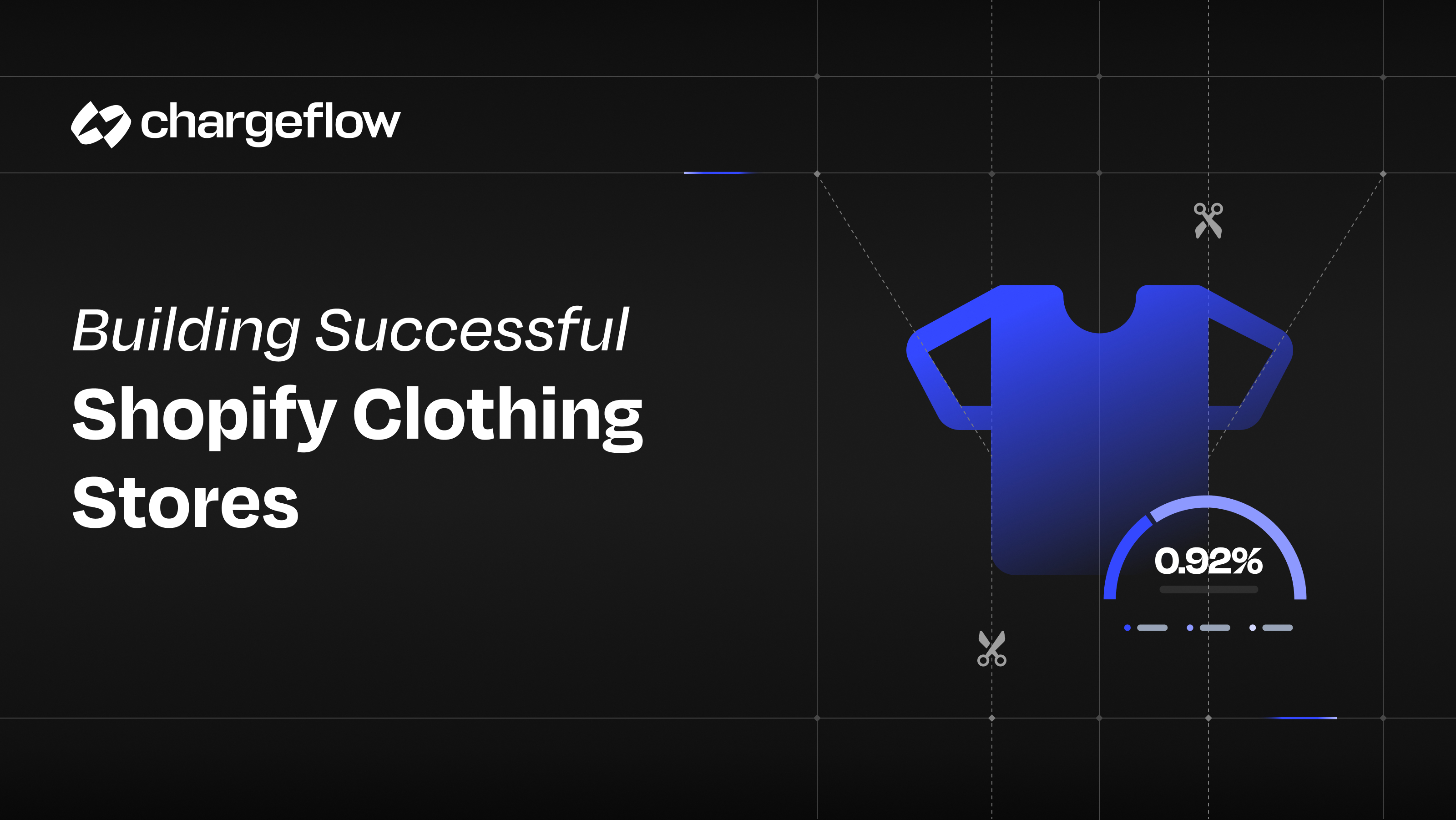Shopify Statistics: Facts and Figures About the eCommerce Behemoth

Chargebacks?
No longer your problem.
Recover 4x more chargebacks and prevent up to 90% of incoming ones, powered by AI and a global network of 15,000 merchants.
Shopify is the fourth-largest eCommerce platform worldwide and the number one digital marketplace in the US. Shopify commands ~10.32% of global eCommerce market share and ~30% of the US eCommerce platform market share.
Shopify is unquestionably a poster child of the ongoing digital commerce revolution. The company prides itself as an “all-in-one commerce platform to start, run, and grow a business.” And they’ve made good on that premise. Shopify has crafted several innovative tools powering entrepreneurs of all sizes.
Financial analysts rank Shopify as the fourth-largest eCommerce marketplace worldwide. They've effectively captured ~10.32% of the market share. Shopify sits comfortably at the top of the US digital commerce pyramid. Analysts say they own ~30% of the eCommerce platform market share.
Keep reading for the most accurate and comprehensive Shopify statistics and facts for 2025. Besides stats on Shopify growth and revenue, you'll get insights into a Shopify merchant’s average monthly revenue, traffic trends, profit margin, and so much more. These market insights will help you improve your business and make better decisions, whether you’re new to the Shopify community or an eCommerce veteran.
We ask that you kindly quote Chargeflow with a link to this article if you wish to use any of the numbers shared here.
Let’s dive right in.
Top Line Shopify Statistics for 2025
- $1,000,000,000,000: The dollar amount of sales revenue merchants of every size have collectively made on Shopify. Shopify brands like Gymshark make over $500 million in sales annually.
- Shopify commands about 30% share of the top million eCommerce sites, with 24% from regular Shopify stores and 6% from Shopify Plus stores.
- Shopify is the leading eCommerce marketplace in the US.
- 1 in 6 internet users worldwide purchased something from a Shopify merchant’s online store in 2024.
- Shopify posted $8.88 billion in the full year revenue 2024, a 26% increase from 2023.
- Shopify merchants hit a record-high $11.5 billion in sales over Black Friday Cyber Monday.
- Shop Pay has 200 million users by Q4 2024.
Shopify Growth Statistics
Shopify has revolutionized the digital commerce world. The eCommerce behemoth has transformed how businesses of all sizes sell and interact with their prospects online.
From notable brands like Gymshack, Huel, Allbirds, Mattel, and Redbull, to celebrities like Victoria Beckham, Taylor Swift, Beyoncé, Adele, and Drake, Shopify is home to ventures that shape cultures.
- Over 875 million people transacted with Shopify eCommerce merchants in 2024, representing 1 in 6 internet users worldwide.
- Shopify crossed 200 million Shop Pay users in 2024, representing over 12% US market share and contributing 38% of GPV, up from 33% of GPV in 2023.
- There are ~ 5.7 million active eCommerce stores built with Shopify. About ~3.2 million of those brands are based in the USA.
- The number of Shopify stores increased by approximately 20% in 2024.
- Historically, ~9.3 million websites have been created with Shopify.
- 3.5% or 34,956 of the top 1 million websites use Shopify to reap the dividends of the eCommerce economy.
- Shopify ranks second in users in the UK, powering 222,542 websites or 23% of the market. Wix Stores has 24% of the market share.
- Shopify’s Gross Merchandise Value (GMV) was up 24% Year over Year in 2024. Shopify’s GMV growth has been more than 20% for six consecutive quarters, marking Shopify's highest GMV growth in three years.
- Shopify is the most integrated platform. Merchants in more than 175 countries use the digital marketplace.
- Shopify commands ~30% share of the top million eCommerce sites, with 24% from regular Shopify stores and 6% from Shopify Plus stores.
- According to Shopify CEO Harley Finkelstein, the 2022 global impact of Shopify entrepreneurs equated to 5.2 million jobs, $28 billion in exports, $229 billion in GDP impact, and $490 billion in economic activity.
- Shopify has ~2.1 million Daily Active Users (DAU) as of 2021. Some analysts suggest the company now has 4.6 DAU.
- Notable brands like Warner Music Group, Champion, Gamestop, Karl Lagerfeld, Goop, Crocs, and David’s Bridal either joined or signed on to join Shopify in Q4 2024 alone.

Shopify Revenue Statistics
Shopify went public in 2015 with a stock price of $17 and a valuation of $1.27 billion. Today, ten years later, its share price has increased by approximately 591%. Shopify currently has a market capitalization of $152.97 billion as of writing. That’s a 61.9% CAGR or 7,284% return on equity fully diluted; with a 116.74 P/E ratio, as analysts have noted.
- Shopify said it surpassed $1 trillion in cumulative GMV this year.
- Shopify posted $8.88 billion in the full year revenue 2024, a 26% increase from 2023 and 3x more than in 2020. Shopify has now delivered 25% or greater top-line growth for seven consecutive quarters, excluding logistics.
- International revenue (all regions outside North America, i.e., Europe, Middle East and Africa region, Asia-Pacific region, and Latin America region) grew by 33%.
- Offline revenue (revenue from Shopify Payments for offline, POS Pro and Retail plan subscriptions and POS Hardware) grew by 33%.
- Shopify's GMV reached ~$300 billion in 2024, which is comparable to the GDP of Finland, and close to 2.5x more GMV than in 2020.
- B2B GMV (representing newer product offerings for merchants only on Plus) grew by 140%.
- Shop Pay GMV rose by +50%.
- Shopify's Gross Payments Volume (GPV) saw a +32% spike, reaching $180.9 billion for 2024 – accounting for 62% of the company's GMV.
- Shopify's free cash flow margin increased to 18%, with free cash flow surpassing $1.6 billion – representing 9 consecutive quarters of positive free cash flow.
- Shopify's operating income in 2024 was 12X more than in 2020 at $1.1 billion.
- Shopify's Monthly Recurring Revenue by Q4 2024 was $178 million, up 24% YoY from $144 million in Q4 2023.
- Shopify's Merchant Solutions Revenue for 2024 was ~ $6.53 billion, reflecting a 73.54% increase.
- Subscription Solutions Revenue for 2024 reached $2.35 billion, a 26.46% YoY growth.
- Shopify's Gross Profit for 2024 was $4.47 billion, up 27% YoY from 2023.
- The company's Operating Margin for 2024 was ~12.2%, a significant improvement from a negative margin in 2023 (operating loss of $1.43 billion).

Operating expense as a percentage of revenue to be 41% to 42%; Stock-based compensation to be $120 million.
Timeline of Major Shopify Funding Rounds to Date
About 68% of Shopify shareholders are institutional investors, such as Baillie Gifford and Company (5.20%) and Morgan Stanley (4.94%). In total, 1,519 distinct institutions hold Shopify shares, while company insiders hold 0.2% of the shares.
Tobias Lütke, the CEO and co-founder of Shopify, owns approximately 6.3% of Shopify's (or 80,997,982 shares), putting his net worth at $10.3 billion. He controls 40% of the voting rights due to the dual-class share structure from Class B shares and a special "founder share" approved by shareholders in 2022.
Shopify's stock holds significant value, making it Canada’s second most valuable company by market capitalization.
Pre-IPO Shopify Funding:
- January 2007, Seed Round: $250,000 at $2.8 million pre-money valuation. This was led by Klister Credit.
- December 2010, Series A: $7 million at $25 million pre-money valuation. This was led by Bessemer Ventures Partners, with participation from FirstMark Capital, and Felicis Ventures.
- October 2011, Series B: $15 million at $75 million pre-money valuation. This round was led by Bessemer Ventures Partners, with participation from FirstMark Capital, Felicis Ventures, and Georgian Partners.
- December 2013, Series C: $100 million at $900 million pre-money valuation. This round was led by OMERS and Insight Partners, with participation from Bessemer Ventures Partners, FirstMark Capital, Georgian Partners, and Felicis Ventures.
Post-IPO Shopify Funding:
- May 2015, IPO: Shopify went public, raising $131 million at $17 per share and debuting on the NYSE and TSX. The Canadian eCommerce software maker was valued at ~$1.27 billion on IPO.
- September 2018, Debt Financing: Shopify issued $600 million in convertible senior notes due this year, 2025.
- September 2020, Debt Financing: Shopify carried out another Issuance of $920 million in convertible senior notes due this year, 2025.
- February 2021, Debt Financing: Shopify raised $2.15 billion through a convertible senior notes offering due in 2026.
Shopify Security and Trust Statistics
Shopify offers a comprehensive suite of plug-and-play eCommerce features to help you start and scale your online business. But they also ship top-tier infrastructure security. You get a highly secure environment for both enterprise and small-scale operations.
- The cloud-based, multi-channel eCommerce platform is fortified with comprehensive security features, such as PCI DSS compliance, SSL certificates, data encryption, fraud analysis tools, and multi-factor authentication.
- The Shopify Whitehat Bug Bounty program incentivizes hackers to find and report security vulnerabilities to Shopify's code.
- Shopify supports scalability. It uses a global CDN, DDoS protection, and 24/7 security monitoring to maintain performance, even during peak seasons.
- In June 2021, Shopify partnered with Chargeflow to help merchants resolve chargeback fraud on autopilot directly from the Shopify admin dashboard. Chargeflow has been rated the #1 chargeback and fraud app for Shopify merchants by Shopify editors and Shopify merchants.
- Shopify says that chargebacks cost merchants at least 0.47% of their total revenue each year.
- The eCommerce service provider uncovered that the average chargeback rate for retailers is 0.52%, even as the Early Warning threshold for card networks like Visa begins at 0.65%.
- Merchants spend up to $35 disputing every $100 in “friendly fraud.”
- Shopify's chargeback fees are $15 per issuance. But unlike many other platforms, they refund this fee if the merchant wins the dispute.
- Shopify says as of early 2023, they implemented new machine learning signals to distinguish good buyers from fraudsters.
- A Shopify case study states they've protected over $13 billion in gross merchandise value (GMV) on behalf of their merchants.
- A merchant using Shopify Payments was said to have observed a 99.9% approval rate on orders and a significant decline in fraud.
eCommerce and Shopify
Shopify has cemented its place as the all-in-one commerce platform to start, run, and grow a business. As President Harley Finkelstein has framed on X, the company’s mission is to:
“make commerce better for everyone and, ultimately, create more entrepreneurs across the world and help them grow bigger and faster.”
- Merchants in over 175 countries use Shopify for commerce everywhere.
- Shopify Payments, its integrated payment gateway, is available in 23 countries. Merchants can use a third-party payment gateway like Stripe in regions where Shopify Payments isn't available.
- Shopify Payments processed $42.9 billion worth of transactions in the third quarter of 2024, up 31% from $32.76 billion in the same period in 2023.
- Shopify launched Shop Pay in February 2017 to speed up the purchase process by storing payment and shipping details for one-click transactions.
- Shop Pay had over 150 million users worldwide, as of early 2024 and 200 million users by Q4 2024. This growth is reportedly fueled by seamless one-click checkout and Integram with platforms like Instagram and Google.
- Shopify says merchants convert as much as 50% better than guest checkout with Shop Pay.
- Shopify launched Shopify Shipping in June 2019 to simplify logistics with discounted rates and label printing with carriers like USPS, UPS, and FedEx.
- Shopify says they've extended Shopify Shipping to seven countries, including France, Italy, and Spain.
- As of January 2025, USPS topped the list of shipping carriers for Shopify online stores globally.
- Almost 264,000 stores have used USPS, followed closely by UPS and FedEx, with 201,464 and 152,146 stores using their services, respectively.
- Merchants using Shopify Shipping are said to have cut their Shipping costs by up to 88%.
- Shopify Email, launched in April 2020 to simplify email marketing for store owners, powers over 4.2 billion emails annually.
- Shopify offered the email service free of charge until October 2020, after which they began charging $1 per 1,000 emails sent, with the first 2,500 emails free per month.
- Email marketing produces the highest conversion rate for Shopify stores at 4.29%. Even though the eCommerce industry average email conversion rate is between 8% to 9%, Shopify says anything above 2% is considered good.
- Shopify released Shopify Audiences in May 2022 to help merchants target high-intent buyers on ad platforms like Meta, Google, TikTok, Pinterest, Snapchat, and Criteo.
- Shopify Audiences has reportedly boosted conversion rates by 15% for merchants using it on platforms like Instagram and TikTok.
- Shopify says users lower customer acquisition costs by up to 50% with Shopify Audiences.
- Shopify Markets, announced in June 2024, streamlines international sales.
- Shopify Markets is said to have helped drive a 97% boost in cross-border transactions for small businesses using its location features, such as currency conversion and market-specific pricing.
- Shopify's enterprise solution, Shopify Plus, powers over 44,801 stores as of early 2025.
- 55% (or 26,000) of Shopify Plus merchants are based in the US. The UK and Australia follow, each with about 3,200 stores.
- According to Shopify, Shopify Plus merchants making $1 million- $500 million are growing an average of 126% YoY, a 690% increase compared to the industry standard.
- Shopify is the most popular platform among the top 1 million eCommerce sites.
- 34,956 or 3.5% of Shopify users make at least 1 million dollars and 8,434 or 0.84 Shopify Plus users are in the top 1 million sites.
- Merchants report 99.99% uptime and a 30% faster checkout experience with Plus features during the biggest flash sales and events of the year.
- Shopify Plus pricing starts at $2,500 per month for a one-year term or $2,300 per month for a three-year commitment. Custom pricing is available for businesses exceeding $800,000 in monthly sales.
- Unlike standard Shopify plans, Plus has advanced features like headless commerce. This distinguishes the front-end and back-end for better customization through the Shopify Storefront API.
- Small businesses make up 74% of Shopify Plus users, while medium businesses account for 14%. Only 6% of Plus users are large enterprises.
- Regarding vertical distribution, 17% of Plus users are in general retail, 11% in Apparel and Fashion and 9% are in manufacturing.
- Shopify launched Shopify POS in August 2013 to give merchants an integrated, mobile, and omnichannel solution for managing sales online and offline.
- Over 100,000 merchants were using Shopify POS as of June 2019, according to Shopify.
- An EY report said using Shopify POS delivers a 22% better total cost of ownership, a 20% faster implementation type, and an 8.9% sales spike.
- Shopify says merchants who plugged their online and in-store sales with Shopify POS noticed a 30% revenue increase YoY.
- Shopify POS has a free option and a Pro option available at $89/month/location.
Shopify Black Friday and Cyber Monday Statistics
Black Friday and Cyber Monday numbers are always mind-boggling. During the Black Friday-Cyber Monday (BFCM) weekend of 2024, Shopify merchants achieved a milestone with sales totaling $11.5 billion – a remarkable 24% increase compared to 2023.
- Shopify says Black Friday shopping spiked at 12:01 p.m. EST when total merchant sales reached a record-high $4.6 million per minute! That was $4.2 million in 2023.
- Cross-border orders represented 16% of all global orders.
- Over 76 million consumers globally made purchases from Shopify merchants during the Black Friday and Cyber Monday weekend, with cross-border transactions accounting for 15% of all Shopify BFCM sales.
- Over 16,500 merchants recorded their first-ever Shopify sales during this period.
- Over 67,000 entrepreneurs registered their highest-selling day ever on Shopify during BFCM.
- The average BFCM '24 cart price was $108.56 ($109.70 on a constant currency basis).
- Sales made via Shop Pay increased by 58% year-over-year.
- Over 91 million packages globally were tracked on the Shop App.
- The hottest product categories include Clothing Tops, Cosmetics, Fitness & Nutrition, Pants, & Activewear.
- The hottest-selling countries include US, UK, Australia, Canada, and Germany, with Los Angeles, New York, London, San Francisco, & Miami leading in hottest cities.
Shopify says they handled 57.3 PB of data from their infrastructure, 1.19 trillion edge requests, 10.5 trillion database queries, and 1.17 trillion database writes over the BFCM weekend—peaking at 284 million requests per minute on edge, and more than 80 million on app servers pushing 12TB per minute on Black Friday!
Shopify App Store Statistics
As of the time of this research, there are over 16,000 publicly available apps across the Shopify App Store. These are offered by Shopify and 37,300 Shopify partners, making the Shopify App Marketplace 4x larger ecosystem than any competitor.
Shopify made ~34 of the apps in their store. Those 34 apps are free and supported by the platform. Third-party developers often charge a fee for their apps and support them independently.
- Shopify says they added over 3,000 new apps to the App Store in 2024, representing +23% increase in apps published.
- Over 80% of Shopify retailers use third-party apps, and Shopify says its users have installed more than 25.8 million apps.
- An average merchant will use at least six different Shopify apps.
- In terms of the profitability of building Shopify apps, Shopify reported that app payouts reached $1 billion in 2024.
- To further spur their earning potential, the eCommerce giant dropped its commissions on app developer revenue to 0%, down from 20%, for developers who make less than $1 million annually on its platform.
- They aim to reset that benchmark yearly to help developers drive their earnings further.
- Industry records suggest that Shopify App developers earn an average annual revenue of $93,000, with the top 25% making ~$167,000 yearly.
- Chargeflow is the top fraud app on Shopify App Store and has received over 250 5-star ratings from merchants and more than 20,000 installations.
Average Order Value for Shopify Stores
An Average Order Value (AOV) is an eCommerce metric used to calculate the average total value of each transaction made with a specific merchant during a defined time frame.
Knowing your AOV is crucial because it helps you track the purchasing behavior of your customers. By analyzing AOV, you gain insights into how much customers are willing to spend on products or services, which helps you make informed decisions on pricing, promotions, and marketing strategies.
- Available data from a survey of 2,261 Shopify stores indicates the average order value for most Shopify stores is around $92.
- Making more than $209 in revenue for each customer you acquire puts you in the top 20% of Shopify stores.
- Exceeding $326 puts you in the top 10%.
- Having an average order value of less than $53 would put you in the bottom 20% of Shopify stores.
- An AOV of less than $42 puts your store among the worst performers.
Shopify Store Traffic Sources
Shopify says having a store on the digital marketplace gives you access to 150 million buy-ready shoppers. It puts your store within 50 milliseconds of every shopper on the planet, with the capacity to handle even the most epic product drops.
- For numerous major verticals, including retail, an average of 33% of website traffic to Shopify stores is attributed to organic traffic.
- Email generates the highest referral conversion rates for Shopify stores at ~4.29%.
- Social media generates 1.81% of referral conversion for Shopify stores.
- 25% of Shopify Stores’ traffic comes from Mobile devices, hence mobile optimization is essential on Shopify.
- The typical conversion rate for mobile devices stands at 1.2%.
- The top 10% and 20% of Shopify stores boast higher mobile conversion rates, with figures of 2.7% and 3.9%, respectively.
- Using 3D commerce results in a 94% increase in conversions for the average Shopify merchant.
- Having a live chat improves the average order value on Shopify stores by 10-15%. Additionally, these proactive chats can increase a store's overall revenue by 13%.
- Most Shopify stores get little less benefit from paid advertising, as estimates suggest paid ads are approximately 15 to 20% less impactful than other forms of marketing like content marketing.
Average Monthly Revenue for a Shopify Store
The average revenue of a Shopify store varies considerably. It largely depends on indices like the business vertical, marketing strategies, pricing, etc.
While it is challenging to extrapolate the exact average monthly revenue for Shopify stores, we know that certain stores generate a few hundred dollars monthly, and others achieve revenues ranging from thousands to millions of dollars.
- A survey done by Shopify in 2020 says on average, Shopify stores generated a monthly revenue of $1,579.
- The top 10% of stores achieved an average monthly income of $10,866.
- Some Shopify dropshippers make as much as $1 million monthly.
That said, we must also underscore that revenue and profit are not the same. Revenue includes various operating expenses like advertising, website maintenance, and product costs. Hence, a merchant could be making positive revenue, but their profit will be in the negative.
A Good Profit Margin for a Shopify Store
A Shopify store’s profit margin depends on factors like the nature of your business, what you're selling, and the level of competition.
- Industry records suggest the optimal profit margin for a Shopify eCommerce store typically hovers around 40%.
- Smaller eCommerce establishments generally maintain an average gross margin of 30%.
- Larger enterprises tend to operate with a 37% gross margin.
- Generally speaking, a net profit margin of 10% is considered average, 20% is considered high, and 5% is considered low.
⚠️Note! Overlooking to track certain costs in your Shopify store can significantly impact profitability. Crucial expenses to track include returns and refunds, payment processing fees, third-party app fees, outsourcing costs, and professional services.
For an accurate representation of your business growth, track pivotal metrics influencing profitability, such as:
- The Conversion Rate, measuring the adeptness of converting leads into customers;
- Customer Acquisition Cost (CAC), evaluating the efficacy of acquiring new customers;
- Average Order Value (AOV), assessing marketing campaign effectiveness and predicting income; and
- Customer Lifetime Value (CLV), providing insights into long-term financial health and customer loyalty.
According to the NYU Stern School of Business, a favorable gross margin for online retail typically falls around 45.25%.
Shopify Employee Statistics
Since its founding by Tobias Lütke and Scott Lake in 2006, Shopify grew to over 11,600 employees in 2023, before laying off around 20% of the workforce in May 2023. The company has since whittled down headcounts, and now has about 8,400 employees, with 4000+ being engineers.
- Shopify's "Digital by Design'' company philosophy allows employees to work remotely and live abroad for up to 90 days.
- The Shopify marketplace has more than 780 experts who help vendors set up or refine their stores.
- The eCommerce behemoth says they’re constantly hiring engineering, UX/UI, and data talents.
Shopify Investment & Acquisition Stats
Shopify has invested in several companies and initiatives over the years. Industry records suggest the commerce everywhere champion has made 42 strategic investments and acquisitions.
Here is the full list of Shopify investments and acquisitions to date (in no particular order):




Shopify’s Social Good Initiatives
Shopify is creating the ultimate commerce platform for everything. They want to help you sell online and in person, expand locally and globally, and reach customers directly and wholesale. Whatever your thing is, Shopify wants to be that platform where you can have uninhibited commerce – online, offline, on desktop or mobile.
Besides revolutionizing the digital commerce world, Shopify is also keen to do good in the world.
“Shopify merchants and ecosystem are thriving. Win by helping others win is the best strategy.” – Tobias Lütke, Shopify CEO.
Here are some notable Shopify Social Good initiatives:
Open Trade, Open for Business
Shopify calls itself a "champion for open trade". This is not limited to encouraging intra-Canadian trade in light of the ongoing US/Canada tariff tussle. The company seeks to also open doors as they build for entrepreneurs everywhere.
- Shopify has extended a record $5 billion in merchant loans and cash advances to vendors worldwide.
- The Shopify Entrepreneurship Index indicates that in 2022, British businesses on Shopify supported nearly 200,000 jobs, including 78,000 directly.
- Globally, Shopify-powered brands supported 5.2 million jobs and $28 million of exports.
- Shopify’s GDP impact and economic activity in the same year amounted to $229 billion and $490 billion respectively.
- Shopify has partnered with Operation Hope to help start, grow and scale 1 million black businesses in the US and Canada by 2030.
Shopify Climate Initiative
Shopify has earmarked a portion of its revenue to sustainability projects. The Shopify Sustainability Fund allocates at least $5 million annually on climate technologies and has pledged an additional $100 million to permanent carbon removal by 2030.
- Shopify says they already power 100% of global operations with renewable energy.
- Shopify receives 30,000MWh yearly from Berkshire Hathaway Energy Canada’s 130-megawatt Rattlesnake Ridge Wind Power Project, southwest of Medicine Hat, Alberta.
- Shopify migrated entirely to Google Cloud in 2018. Google matches 100% of energy use with renewables making Shopify a carbon-neutral platform.
- A 2023 Climate Report says Shopify has signed contracts totaling $55.7 million across 39 companies to deliver 84.4k tonnes of durable carbon removal.
- Shopify pays the green premium for clean fuels to help accelerate transportation decarbonization to create a more sustainable future of commerce.
- In 2022, Shopify signed a first-of-its-kind agreement with clean fuel company Twelve to help promote the adoption of their fuel by commercial airlines and freight carriers.
- The $2.5 million deal meant Shopify would pay the green premium for Twelve's E-Jet®: aviation fuel, which currently costs more than fossil jet fuel but has an 80%+ lower carbon footprint.
- In the same year 2022, Shopify founded Frontier, an advance market commitment to buy an initial $925 million of permanent carbon removal by 2030, alongside Stripe, Alphabet, Meta, and McKinsey Sustainability.
- In 2023, the combined commitment grew to over $1 billion with the addition of new members Autodesk, H&M Group, JPMorgan Chase, and Workday.
- Frontier members signed four offtakes ranging from $20 million to $57.1 million with suppliers that are ready to scale commercially, and 12 $500,000 pre-purchases with high-potential suppliers at proof of concept and pilot scale.
- Shopify launched the Shopify Planet app in 2022 to power carbon-neutral shipping and help merchants connect with climate-conscious consumers.
- At the end of 2023, 24.8 million carbon-neutral shipments and 20.1k tonnes of carbon dioxide had been removed from the atmosphere thanks to Shopify Planet.
In closing this research, I leave you with this inspiring quote from Shopify President Harley Finkelstein:
“When we look ahead, we aren’t just looking at the next quarter. We are focused on the big picture, which is building a durable 100-year company. We are focused on making commerce better for everyone, and every size of merchant from entrepreneur to enterprise, because we succeed when our merchants succeed.”
I love this company, there’s no denying it. And I believe their 100-year vision is real. I hope you enjoyed reading this work.
DISCLAIMER:
This research provides general and factual information as of the time of writing. Chargeflow and its operators/employees assume no liability for the information given being complete or correct. Due to varying update cycles, statistics can display more up-to-date data than referenced in the text.
***
SOURCES:

Chargebacks?
No longer your problem.
Recover 4x more chargebacks and prevent up to 90% of incoming ones, powered by AI and a global network of 15,000 merchants.






























.png)








